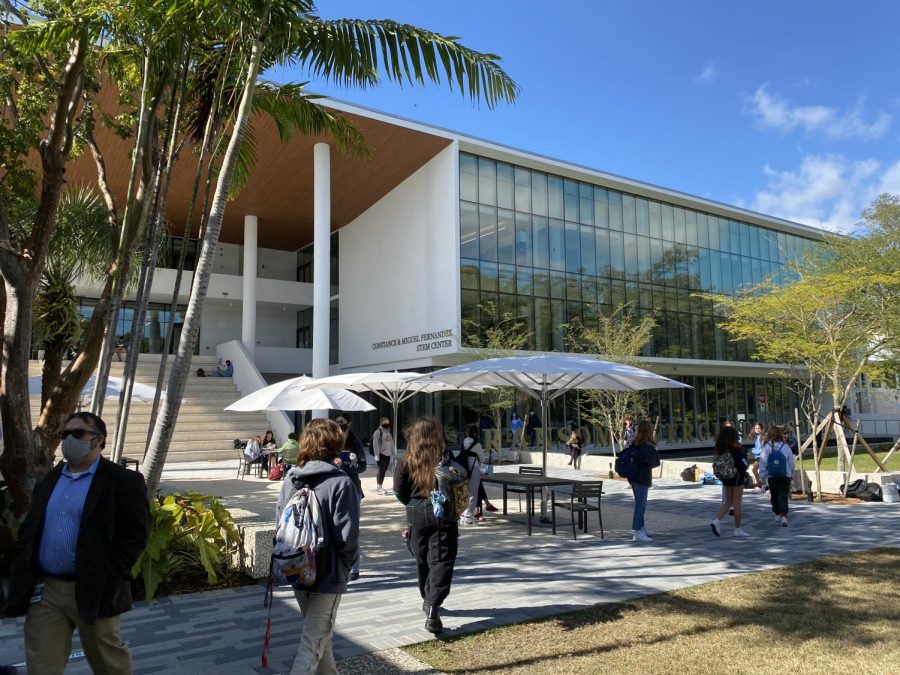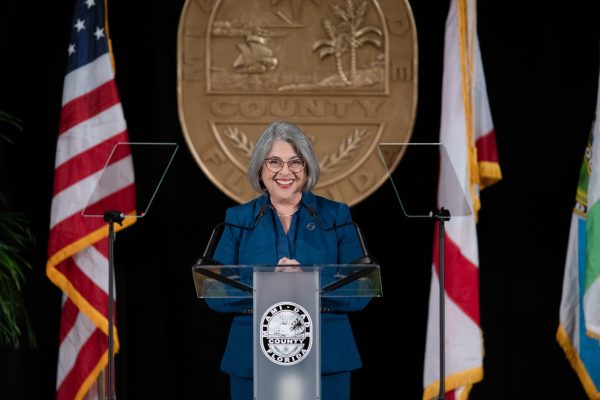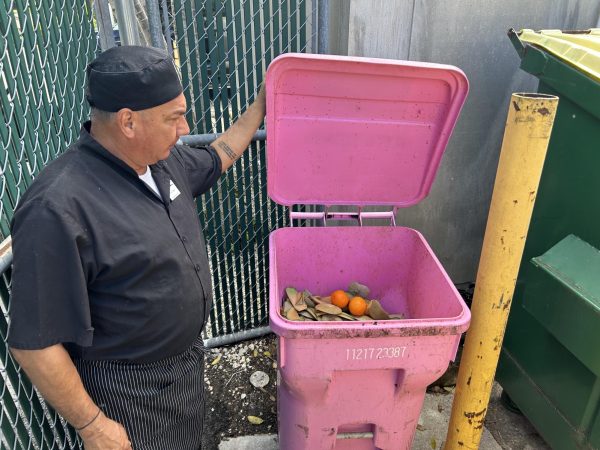How the STEM Center has changed the way students learn and interact
Students break in the shade of the Touzet Quad or bask in the sun of the STEM steps between classes.
Ransom Everglades broke ground on the Constance and Miguel Fernandez STEM Center on December 13, 2018, and ever since then, the RE community has been excited to use it. Two years later, its doors officially opened during the heat of the COVID-19 pandemic. Students of all grades are finding that this three-story glass structure has created a welcoming setting for collaboration and innovation, inside and outside of the classroom.
Dr. Douglas Heller, the head of the STEM Department, said that “this building is designed for interactivity and collaboration.” The new protocols due to the pandemic, such as mask wearing and one-way traffic in buildings, have made this an interesting year to open a new part of campus, but “even with limitations due to social distancing, it is so gratifying to see students finding both its outdoor and indoor spaces so inviting,” said Dr. Heller.
Dr. Brittney Ellzey, a math teacher who previously taught in the mobile trailers on the tennis courts, coined as the Aulas, concurred with Dr. Heller. “It is very neat to learn and teach in such a modern high-tech building that has such a college feel. Moving to the STEM building was a much easier adjustment than it would have been to move back to the Aulas,” Dr. Ellzey said.
She is extremely satisfied with her setup in the new building, which involves multiple screens and allows for smooth communication with students who are learning virtually. Dr. Ellzey laughed as she said, “I think we’re spoiled in this building.”
Although the STEM Center has only been a part of the Ransom Everglades campus for a few months, students from all grades could not imagine their high school experience this year without it. The building has changed how students learn and interact in their daily lives.
Students find great enjoyment in the huge glass windows, collaborative study spaces and the adjustable tables in the STEM building classrooms. Gori Spillis ’21 takes Engineering in a ground-floor STEM classroom, and he mentioned that although the glass windows can be distracting at times, he loves feeling the fresh air during class when the windows are open. “It is so unique to learn about math-science topics in an open-air room so close to nature,” said Spillis.
Dylan Miner ’23 said that the building “has helped improve her study skills.” She often ventures to the third floor of the STEM building in her free period to get her work done. The adjustable tables and convenient outlets generate a comfortable setting for Jake Meyer ’22 to take notes in Biology class. “The setup in the STEM classrooms makes me more eager to learn than in other buildings on campus,” said Meyer.
Not only has this massive glass building improved the teaching and learning environment; it has also given students more opportunities to socialize during a year in which human connection can be hard to come by. “The STEM building makes Ransom feel like an even more tight-knit community than it already is,” said Kelli Miller ’21.
The STEM building has allowed Jaden Simkins ‘24 to not only learn in a different way, but also interact with people from all different grades. On a typical day at the STEM Center, she immediately goes from learning about Geometry to talking to her friends on the STEM steps.
“I was initially very nervous about my transition to the high school with all the new protocols, but the STEM building has made the transition smooth by being a great place for me to get to know my teachers, friends, and people from all grades better,” mentioned Simkins.
Like any new building, the STEM Center has presented some problems, too, especially for students learning virtually. Helaina Harris ’21, who attended school remotely until the middle of January, said that the air conditioning in the building made such loud noises that it was difficult to hear the teacher and students. Blythe Heller ’22, a student who has been virtual for the whole school year, agreed with Harris’s assessment. “I can hear my classmates better when they are in Ludington classrooms,” Heller said.
The school is aware of the noise issue, and has not yet announced whether it has developed, or is developing, a solution. But Dr. Heller stressed that the version of the STEM Center students are experiencing now is just the beginning. When social distancing guidelines eventually relax, students will be able to make full use of the newly outfitted labs. The Visual Arts and STEM departments have been working on developing a bridge between those interested in both the arts and the sciences; next year, they will offer an interdisciplinary class covering art and technology that utilizes the new makerspace on the first floor. Environmental and sustainability projects on the roof of the building are also on the agenda. Sophie Bernstein ’21 said she’s “jealous of the underclassmen who will get to experience these new programs in the years to come.”
The building is “an investment in our future,” said Dr. Heller, “one that allows for flexibility and growth in the curriculum and a responsibility we don’t take lightly.”






